![Jerry Hammes.com [Logo]](../../../images/logo.jpg)
|

|
Competition Plus, Internet Magazine - 2007
[Back to topic list] [Back to Some Of The Other Shows Topic] King of the Blue Oval Dick Brannan led the charge of the Fabulous Fords By Steve Reasbeck; Photos courtesy Dick Brannan, www.georgiadragracing.com, www.prostockhemi.com, www.fordsouth.com 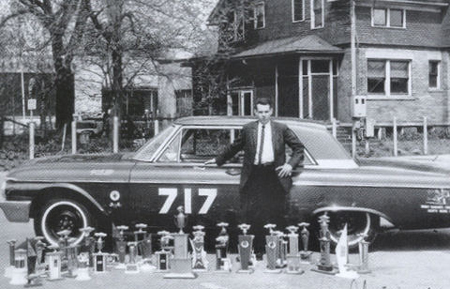 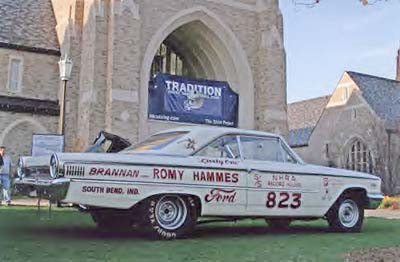 In 1963 Dick Brannan received the first of the famed lightweight Galaxies. His was hand-built by Ford, and heralded the beginning of special "package" drag cars from the famous manufacturer in Dearborn, Michigan. Back in the 60s the racing landscape and its relationship to the fans was different. In 1963 Dick Brannan received the first of the famed lightweight Galaxies. His was hand-built by Ford, and heralded the beginning of special "package" drag cars from the famous manufacturer in Dearborn, Michigan. In today's motorsports environment the driver is marketed to the fans, first and foremost. NASCAR's Jeff Gordon, Dale Earnhardt Jr., and others are promoted as personalities. Drag racing is much the same way, with drivers being sold as individuals, without much regard as to the make of car they drive. In the 60s, however, the vehicle's marque was of utmost importance. Loyal Mopar, Ford, and GM fans were as rabid regarding the make of vehicle as any Pittsburgh Steeler fan and the person behind the wheel was secondary. The drivers of the day were recognized for the vehicle they drove, and those who made the "switch" were seen as treasonous as Benedict Arnold. Each make and manufacturer had its heroes and these were identified by their relationship with that manufacturer. Pontiac had Arnie Beswick, Chevrolet had Bill Jenkins, and Chrysler had the great Ronnie Sox, Bill Stiles, Herb McCandless, Dick Landy and many others. All were extremely successful and became household names. Mercury had Don Nicholson and Eddie Schartman, and Ford had, among others, Phil Bonner and Hubert Platt. The coordinator of them all was Dick Brannan, a long-time Ford racer who had been instrumental in getting the entire Ford racing program off the ground. 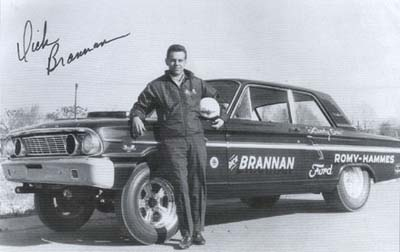 The factory wars escalated in 1964, and Ford countered Chrysler's Hemi-equipped sedans with the Thunderbolt, based on the mid-sized Fairlane. As with the '63 Galaxie, Brannan was the recipient of the first "T-bolt." "I had always been a Ford guy, ever since the day I came out of the Navy," said Brannan. He recalled the beginning of the Ford racing effort back in the early 60s when Dearborn began to get serious. "I went to work for Ford in 1962 as an 'outside consultant,' almost an undercover type operation." Brannan was key to the formation of the Ford drag team. "The original players were Les Ritchie, Gas Ronda, Ed Martin, and myself. Bob Tasca was also real important in its formation in the summer of 1962. Just to show that Ford was serious, we had the original ten aluminum-paneled 406 Galaxies, and they were given to the original team." Those cars were very successful, and whet Ford's appetite for success. The concept was refined, and they were replaced with a similar version for 1963, the famed lightweight Galaxie. "Those engines were the beginning of the 427 side-oilers, and they rang up a big win record." Of the famous 63s, Dick had the first one. "Mine was hand-built, while the rest were done over at Dearborn Steel. Mine was the only one with a beige interior, while all those that followed were red. If you check the models, the die casts that are available today, they have the beige interiors, just like mine." 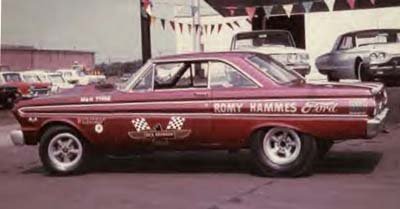 In 1964 the Thunderbolt was joined by the even lighter Falcon, also equipped with the 427-inch bullet. Only two were built, and Dick Brannan had one of them. This would be the beginning of special "package" Ford drag cars, and the originals are of great value to collectors today. Believe it or not, all of Dick's first four cars still exist, and are owned by the same owner, Don Snyder of the Youngstown, Ohio, area. "Ford wanted those cars up there for their 100th Anniversary celebration, so they made arrangements to have them sent up, and then redelivered them to Don. It was amazing". 1964 would see Ford place more emphasis on smaller cars, largely due the upcoming re-release of the famous Chrysler Hemi. "We weren't sure what to expect, but we knew it would be tough, so we pulled our ace out," Brannan said. Again, Brannan was first, with the initial 427 Thunderbolt. The Thunderbolt was based on the Fairlane platform, and reached legendary status. It more than held its own against the larger MoPars. "The T-bolt had aluminum everywhere, and was really trick. We knew that this war, if you will, was going to get more intense, so it was about that time we started toying with the Falcon idea," Brannan said. There were two built, only one by the factory. The Falcon was considered a compact car, and was a small car for its day. "I had the first and only 427 Falcon, there were no other factory built cars," said Brannan. "We actually wanted a Mustang, which was built on the same platform. They were selling all the Mustangs they could build, though, and Ford did not have a Mustang available for us to use, so we developed the Falcon. We actually used the data from the Falcon to build the Mustangs as they became available." 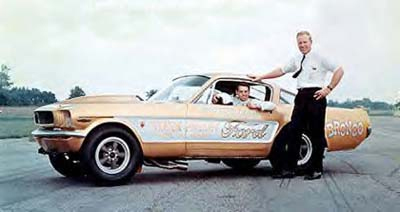 By 1965 Brannan had a Mustang equipped with the legendary SOHC 427 Ford engine, which was a hemi-headed engine with a camshaft in each cylinder head. This was the first factory-produced Ford Funny Car. NHRA had created a class, A/FX (Factory Experimental), specifically for these types of hybrids, and the smaller Fords were the major player. Ronnie Sox, the late Chrysler great, actually won the 1964 NHRA World Championship with a Mercury Comet version of the T-bolt. In 1965, Chrysler, in a marketing move, decided to stick with the larger mid-size B bodies, but with a twist. They showed up at the 1965 NHRA Winternationals in Pomona with the wheels moved all around, thus creating the first Funny Cars. "We couldn't believe it when we saw them," said Brannan. "We had heard rumors but were not quite ready for that." The MoPars immediately got the heave-ho from "legal" NHRA competition, which opened the door for the Fords to take the lead role. By 1965 Brannan could get all the Mustangs he wanted, and it was also the first year for the legendary SOHC 427 Ford engine. A hemi-headed engine with a camshaft in each cylinder head, it was actually ahead of its time. Brannan remembers the engine development very well. "The technology just did not exist to develop it to its potential, although it was still very successful." The week link appeared to be the eight-foot-long timing chain. "The problem is the chain would stretch. We would run the motors to around 8800 rpm, and the chain would stretch and retard the left bank." They still rang up a good win record, in spite of the teething problems. "We ran them in a lot of our FX cars, and Connie Kalitta and Don Prudhomme had a lot of success in '66 on fuel in dragsters." Although built in very limited numbers, and long since gone from the drag racing scene, Dick is amazed at how many of the "cammer" power plants are still around. "At our recent Ford show in the Atlanta area, there must have been thirty of them there. I don't know where they are getting them."  The 1966 version of the SOHC-equipped "outlaw" Mustang Funny Car. As the cars went quicker and faster, problems sprang up. "They were small cars and they began to handle somewhat poorly," said Brannan. "Les Ritchey was fatally injured in Southern California and I had a bad accident myself. This resulted in the stretch-nosed Mustangs." The accidents, plus some wind tunnel tests, produced information. "We found that stock, they had about 12 pounds of down force, which is not nearly enough. So, we stretched the wheelbase, added a spoiler, and that took care of it." The factory cars of Tasca Ford, driven by Bill Lawton, Phil Bonner, Gas Ronda, Hubert Platt, and ringleader Brannan, continued to keep the blue oval right in the front of the pack. First On Race Day was Ford's acronym, and their success is remembered to this day. They had entered the "outlaw" match race fray in 1966, and their wars with their Chrysler counterparts are today considered by many to be the highlight of the "golden era" of our sport. The history of Ford racing of that time period would not be complete without mentioning the "Super Stang," which was an enclosed-cockpit dragster built by Logghe Chassis and powered by an injected SOHC "cammer" 427. "That was an exercise by Ford styling, and I had my fingers in that as well," Brannan said. Although not seen much in actual competition, the car found a legendary driver to tour with it. "Tom McEwen, the 'Mongoose,' the well known top fuel pilot, drove it, and it was used primarily for exhibition. It was a real hit." 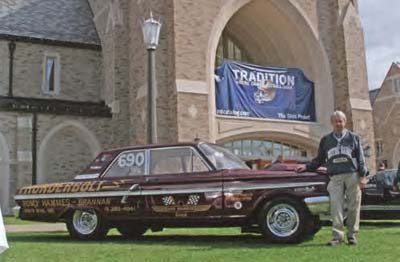 Today, Brannan is a producer of large Ford-only shows and events, and his shows in different parts of the country are large and successful. His love for the blue oval and its high-performance heritage has never waned. As racing became more sophisticated and expensive, and even more "corporate," Brannan left it behind in 1968. There were a couple of efforts to follow, though. "We ran a 1970 Maverick in Pro Stock, and then went on and ran a '72 Pinto. But that was pretty much it." Brannan went on to a career in the aviation business, spending thirty years working in that field. He still keeps track of the races, though, and is very involved in the Ford show/race scene. "I attend the NHRA event each year at Commerce, Georgia, and enjoy it. It is completely different now, but that is part of life. Everything changes. It is hard to compare then and now, it is just so different." He is a producer of large Ford-only shows and events, and his shows in different parts of the country are large and successful. His love for the blue oval and its high-performance heritage has never waned.  As racing became more sophisticated and expensive, and even more "corporate," Brannan left it behind in 1968. There were a couple of efforts to follow, though. "We ran a 1970 Maverick in Pro Stock, and then went on and ran a '72 Pinto. But that was pretty much it." As far as tough competitors, Brannan remembers many. "Ronnie Sox and Buddy Martin, of course. Dyno Don Nicholson was one of the greatest. And the Ramchargers were tough, and they seem to have been overlooked by many of the historians." Brannan can be found today heavily involved at several large Ford only events, events that he helps produce. Information on these events can be found at www.fordsouth.com and www.fordsouthwest.com, and are a must-attend, not only for Ford aficionados, but also for drag racing historians. They also host a major Ford event at Notre Dame University in South Bend, Indiana. Also, there is a slick CD available from Dick Brannan himself, at www.dickbrannan.com, which covers much of the history of drag racing during that period. In today's environment, with eighteen wheel transporters and related support vehicles, as well as teams that feature PR departments and executive chefs, it is easy to forget the folks that built this sport. Many have drifted into history, gone unnoticed and with their accomplishments now just a faded memory. Dick Brannan and his colleagues continue to remind us of this sport's heritage by attending and promoting events that celebrate that heritage. |
 |
 |
 |
 |
 |
 |
 |
 |